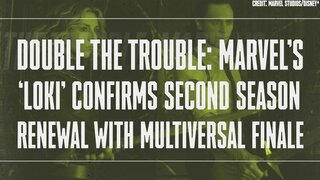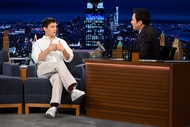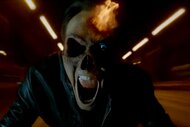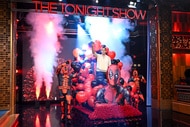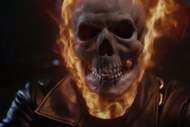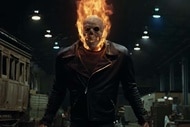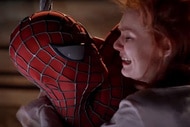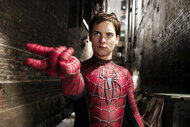Create a free profile to get unlimited access to exclusive videos, sweepstakes, and more!
From Hulk-induced trauma to Time Door scuffs: Pulling back the curtain on Loki's killer look
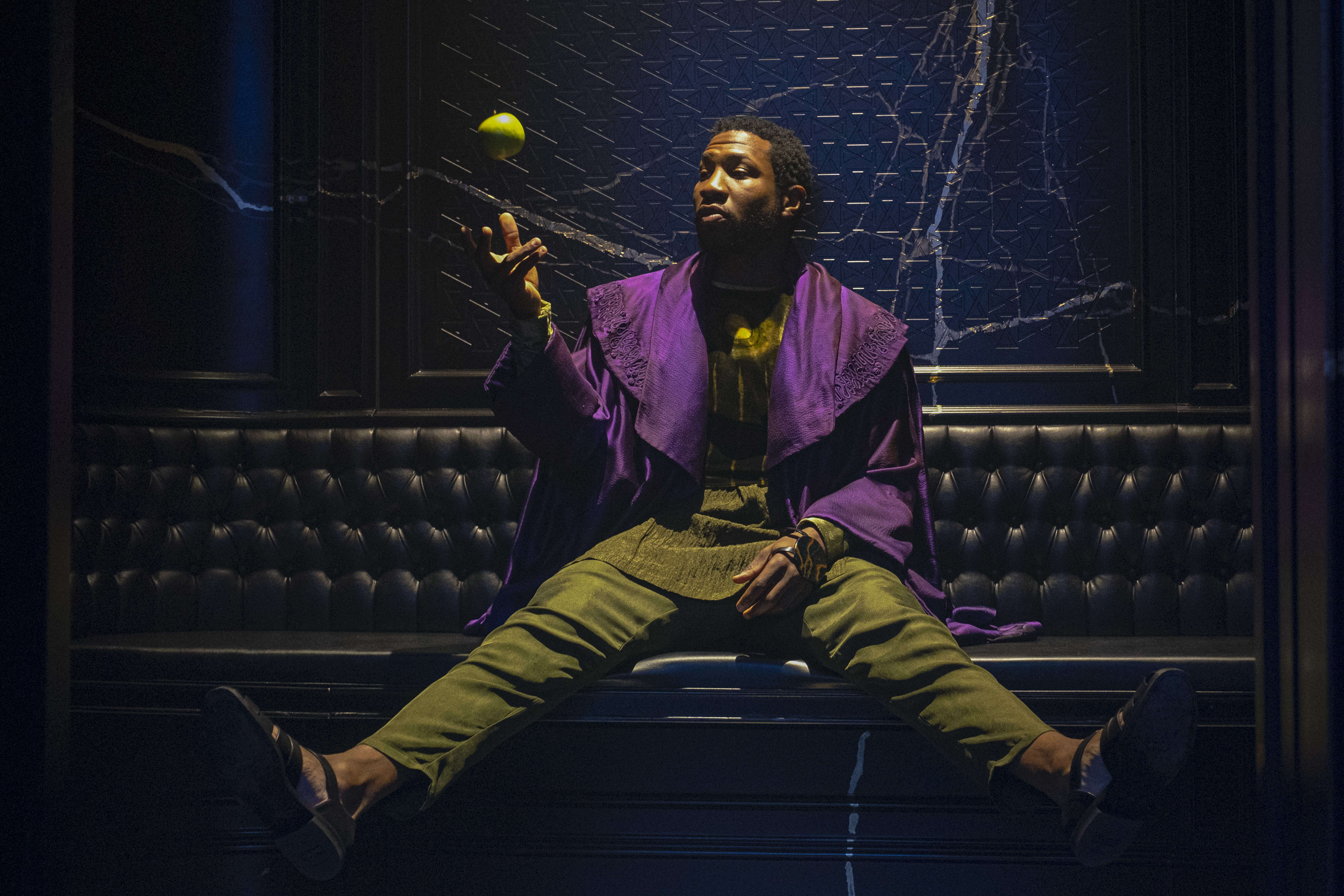
There's a clever meme currently making its way across the internet that essentially blames the creation of the entire Marvel Multiverse on Hulk's fury over having to take the stairs in Avengers: Endgame.
It's actually quite ironic that Bruce Banner's (Mark Ruffalo) angry alter ego violently subdued Loki (Tom Hiddleston) in 2012's The Avengers only to help facilitate the villain's Space Stone escape in his very own TV show on Disney+. This leads to the arrival of the Time Variance Authority, which leads to Loki meeting Sylvie (Sophia Di Martino), which leads to Sylvie opening the door to infinite timelines. Well, there were a few other steps in between, but you get the point.
"With reference to trauma caused by Hulk on Loki's face, I never dreamed in a million years that wounds created a decade ago would come back into play again and serve as connective tissue to different stories," Douglas Noe, a makeup artist who has worked alongside Hiddleston since the first Avengers movie, tells SYFY WIRE during a Zoom interview.
Noe describes Hiddleston as "an encyclopedia" of Marvel Cinematic Universe wisdom. "Nobody knows more about the Loki-verse than Tom, so it made perfect sense. There was never gonna be any breaks in communication or miscommunications because I'm with him all the time," he says.
Unlike previous Marvel projects where he only served as the sole makeup artist for Hiddleston, Noe got to run the entire (makeup) show on Loki. "I think [Tom] knows that the artistic integrity is gonna be tighter because we have a very cohesive and fluid line of dialogue," he explains. "Sometimes, we don't even have to say anything, we just understand each other. I think that's only natural after you spend time with somebody. But that was Tom saying, 'OK, you're gonna take care of me, but you're also gonna take care of it, and here we go.'"
While Noe focused on the actors, visual effects vendor FuseFX set out to define the sci-fi capabilities of the TVA. Chatting with us over the phone, Fuse supervisor Wayne England reveals that the studio helped develop the look of important narrative elements like the pruning effect that occurs when a variant is deleted from existence (and as we later learn, sent to the Void).
"There was evolution in terms of the concept, but it wasn't too long until we were arriving at conversations that were speaking to the look of [a] nebula," he says. "I had in my mind that image of the show Cosmos, where it looks like something has exploded and has left an energetic trail. It leaned with a kind of plasma, white-hot energy that was transitioning into a different state of energy that was, in a sense, a trail of the leading edge that was transporting the person to somewhere else."
One of several VFX houses drafted into the massive Loki effort, Fuse worked closely with the show's lead visual effects supervisor, Dan DeLeeuw (an alum of several MCU projects, including the latest two Avengers films). "He was very appreciative of the efforts that we were making," England continues. "His direction was subtle and I really appreciated how his feedback was so nuanced and in a few words he would say a lot. Those are the kinds of things that I was really appreciating. He's very relaxed, very relatable — and it was always toward very sensible good ends that he was directing."
Fuse also proved instrumental in the rendering of the Time Doors the TVA personnel use to travel between realities and branching timelines. "It was a lot to do with the echoing of time, so that when somebody approached the door you would see an echo of the person shifted in time before they actually passed through the threshold of the Time Door," England adds. "And then it was the same once they'd passed through; there was a ghosting of their effect, a kind of a blurring out."
A subtle aspect of the Time Doors is that they appear worn and used upon further inspection. It's a rather negligible detail, but one that connotes the eons-old nature of this temporal bureaucracy that runs off a combination of analog machinery and a science so advanced, it's pretty much indistinguishable from magic (just like Thor told Jane Foster in 2011).
"Because they were kind of a utility function — they were kind of beat up and used a bit, so they did also appear to be a little bit worn in a sense," England says. "It wasn't this pristine [thing]. Even though it was a dimensional portal, it was contextualized as a utility, and so it had scuffs and marks. Even though the surface was somewhat mysterious, given what it did in terms of being a literal threshold portal, it nevertheless seemed like a utility device."
Another resource used by the organization is the Time Theater, in which an analyst can revisit the "greatest hits" of a variant's life. These moments appear as holographic projections on a screen made up of dozens of ever-changing squares.
"We had been given reference of murmurations — like Starlings when they're flying in the sky and then all of a sudden, you see a shift and there's a coordinated patterning," he says. "That was a really nice reference that we were given for the Time Theater for when it's in its default state. We'd also programmed its ability to take on different forms, so another shot we worked on was when it formed from its default state and transitioned into forming the TVA logo."
Meanwhile, on the non-digital side, Noe's directive for TVA employees was "to keep them naturally beautiful." It's a rule that applied to Sylvie, Revonna Renslayer (Gugu Mbatha-Raw), and Mobius (Owen Wilson).
"Mobius being a little bit of a rebel had some scruff," Noe explains. "The nice thing about Renslayer, [is that] she is in a higher level than the hunters, so we did a little more to her. Just turned up the volume on her own beauty just a bit and just accentuated what she had."
In other instances, the makeup team took suggestions from the actors, such as Neil Ellice, who played Hunter-90. "If you see any close-ups of him, you'll notice that he's got some scars on his forehead and eyebrow from previous conflicts. That was Neil's idea," Noe explains. "There are other things, but more creative character conversations are had based on what we learn after viewing the footage from the camera tests. From there, just prior to beginning principal photography, my team and I discuss the looks for actor and determine an approach that utilizes artists' talents to suit actor needs."
The sixth and final episode confirmed a major fan theory with the introduction of He Who Remains (played by Lovecraft Country's Jonathan Majors). It turns out the TVA was not the product of the Time-Keepers, but the brainchild of a brilliant 31st-century scientist who decided to prune other timelines in order to prevent an inter-dimensional war between his more belligerent variants. Like Kang the Conquerer, for instance. Despite this major reveal, however, Noe didn't need to exaggerate the look of the mysterious man behind the curtain.
"I just wanted him to look clean and well-kept," he says. "I think makeup artists and hair stylists know this: There's a time when the most important thing we can do is nothing. Just let it be. It wasn't broken, if you will. All we did was even him out and make sure he wasn't shiny."
The Season 1 finale confirmed that Loki will be the first MCU show to officially return for a second season, but Noe and England aren't entirely sure if they'll be asked back.
Luckily, Noe has a pretty effective strategy for not getting his hopes up. "I don't assume anything, and I'm never disappointed," he admits. "One of the many wonderful reasons I love the Marvel Universe [is because] I'm in the dark until the first production meeting. I'll get a call six or eight weeks out. I suspect I'll get that call [but] when I'll get that call, I don't know."
When the phone does finally ring, the makeup artist will be ready to jump back into the fray. "I really am allured by the unknown," he continues. "I've never done anything else in my life, so career-wise, whatever they dream up, bring it on. I'm not gonna speculate on what they'll do because they've got a handle on it. I'll do whatever they want ... It really is attractive because they're not gonna hurt you. They just keep raising the bar."
"The bigger, the better — just in terms of the scope of visual effects," England declares when we ask about what he'd like to see out of the next season. "If we can find ourselves doing more inter-dimensional wondrous shots, that's exciting. Any opportunity, I would say, to continue working with Marvel is a win because of the nature of the content, because of the quality of the work, the franchise. How significant it is relative from our day and age and the love for Marvel is so big, so the idea of working on more Marvel [content] is fun to think about."
All six episodes of Loki's debut season are now available to stream on Disney+.
